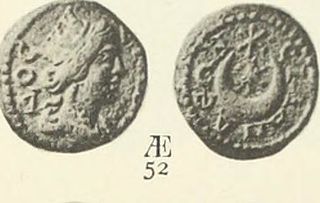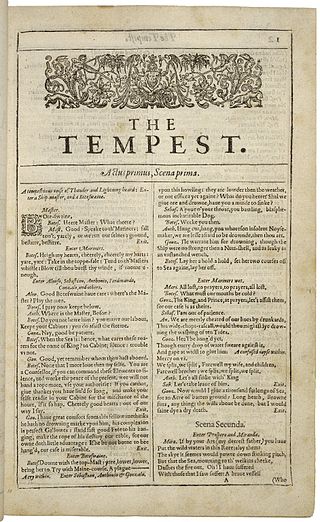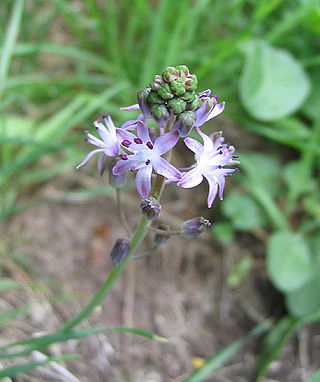
Prospero Alpini was a Venetian physician and botanist. He travelled around Egypt and served as the fourth prefect in charge of the botanical garden of Padua. He wrote several botanical treatises which covered exotic plants of economic and medicinal value. His description of coffee and banana plants are considered the oldest in European literature. The ginger-family genus Alpinia was named in his honour by Carolus Linnaeus.

Prospero is a fictional character and the protagonist of William Shakespeare's play The Tempest. Prospero is the rightful Duke of Milan, whose usurping brother, Antonio, had put him to sea on a "rotten carcass" of a boat to die, twelve years before the play begins. Prospero and Miranda had survived and found exile on a small island. He has learned sorcery from books, and uses it while on the island to protect Miranda and control the other characters.

Prospero's Books is a 1991 British avant-garde film adaptation of William Shakespeare's The Tempest, written and directed by Peter Greenaway. Sir John Gielgud plays Prospero, the protagonist who provides the off-screen narration and the voices to the other story characters. As noted by Peter Conrad in The New York Times on 17 November 1991, Greenaway intended the film “as an homage to the actor and to his 'mastery of illusion.' In the film, Prospero is Shakespeare, and having rehearsed the action inside his head, speaking the lines of all the other characters, he concludes the film by sitting down to write The Tempest.”

The Masque of the Red Death is a 1964 horror film directed by Roger Corman and starring Vincent Price. The story follows a prince who terrorizes a plague-ridden peasantry while merrymaking in a lonely castle with his jaded courtiers. The screenplay, written by Charles Beaumont and R. Wright Campbell, was based upon the 1842 short story of the same name by American author Edgar Allan Poe, and incorporates a subplot based on another Poe tale, "Hop-Frog". Another subplot is drawn from Torture by Hope by Auguste Villiers de l'Isle-Adam.

The Tempest is a 1979 film adaptation of William Shakespeare's play of the same name. Directed by Derek Jarman, produced by Don Boyd, with Heathcote Williams as Prospero, it also stars Toyah Willcox, Jack Birkett, Karl Johnson and Helen Wellington-Lloyd from Jarman's previous feature, Jubilee (1977).

Sycorax is an unseen character in William Shakespeare's play The Tempest (1611). She is a vicious and powerful witch and the mother of Caliban, one of the few native inhabitants of the island on which Prospero, the hero of the play, is stranded.

Silandus or Silandos was an episcopal city in the late Roman province of Lydia. It was near and gave its name to the present town of Selendi in Manisa Province, Turkey.

Ariel is a spirit who appears in William Shakespeare's play The Tempest. Ariel is bound to serve the magician Prospero, who rescued him from the tree in which he was imprisoned by Sycorax, the witch who previously inhabited the island. Prospero greets disobedience with a reminder that he saved Ariel from Sycorax's spell, and with promises to grant Ariel his freedom. Ariel is Prospero's eyes and ears throughout the play, using his magical abilities to cause the tempest in Act One which gives the play its name, and to foil other characters' plots to bring down their master.

The Tempest is a play by William Shakespeare, probably written in 1610–1611, and thought to be one of the last plays that he wrote alone. After the first scene, which takes place on a ship at sea during a tempest, the rest of the story is set on a remote island, where Prospero, a complex and contradictory character, lives with his daughter Miranda, and his two servants: Caliban, a savage monster figure, and Ariel, an airy spirit. The play contains music and songs that evoke the spirit of enchantment on the island. It explores many themes, including magic, betrayal, revenge, and family. In Act IV, a wedding masque serves as a play-within-a-play, and contributes spectacle, allegory, and elevated language.

Prospero autumnale, the autumn squill, an autumnal flowering plant of the family Asparagaceae, subfamily Scilloideae, is found in the Mediterranean region from Portugal and Morocco east to Turkey and the Caucasus, plus Great Britain. Despite being classified as a single species, it is actually a cryptic species complex, with a variety of cytotypes having been discovered which are phenotypically indistinguishable from each other.
Der Sturm is a German-language opera in three acts and an epilogue by the Swiss composer Frank Martin to a libretto based on the Schlegel/Tieck German translation of Shakespeare's The Tempest.

Prospero is a genus of bulbous flowering plants in the family Asparagaceae, subfamily Scilloideae. It is distributed in Europe, around the Mediterranean, and through the Middle East to the Caucasus.

The Tempest, also known as The Tempest (Prospero and Miranda), or simply Prospero and Miranda, is an outdoor bronze sculpture depicting Prospero and Miranda from William Shakespeare's The Tempest by Milton Hebald, installed outside Delacorte Theater in Manhattan's Central Park, in the U.S. state of New York. The work, which was donated by George T. Delacorte, Jr. and unveiled in 1966, is a companion piece to Romeo and Juliet (1977).
Prospero battagliae is an autumnal flowering plant of the family Asparagaceae, subfamily Scilloideae endemic to Crete, Greece. It is a tetraploid species in the Prospero autumnale cryptic species complex, described from the Lasithi Plateau.
Prospero hierapytnense is an autumnal flowering plant of the family Asparagaceae, subfamily Scilloideae endemic to Crete, Greece. It is a tetraploid species in the Prospero autumnale cryptic species complex, described from the area near Kavousi.
Prospero minimum is an autumnal flowering plant of the family Asparagaceae, subfamily Scilloideae endemic to Crete, Greece. It is a diploid species in the Prospero autumnale cryptic species complex.
Prospero rhadamanthi is an autumnal flowering plant of the family Asparagaceae, subfamily Scilloideae endemic to Crete, Greece. It is a diploid species in the Prospero autumnale cryptic species complex.
Prospero idaeum is an autumnal flowering plant of the family Asparagaceae, subfamily Scilloideae endemic to Crete, Greece. It is a diploid species in the Prospero autumnale cryptic species complex.
Prospero depressum is an autumnal flowering plant of the family Asparagaceae, subfamily Scilloideae endemic to Crete, Greece. It is a diploid species in the Prospero autumnale cryptic species complex.
Prospero paratethycum is an autumnal flowering plant of the family Asparagaceae, subfamily Scilloideae native to the Pannonian Basin. It is a diploid species in the Prospero autumnale cryptic species complex.










